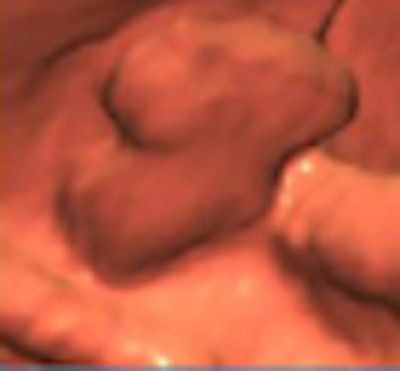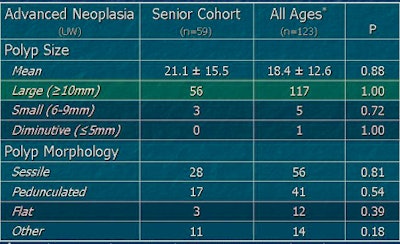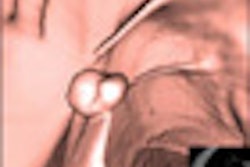
Screening with virtual colonoscopy (also known as CT colonography or CTC) is as useful for older individuals as it is in the general population 50 years and older. Although Medicare-aged screening participants present with higher rates of extracolonic lesions, advanced adenoma findings are remarkably similar between the two groups, according to researchers at the University of Wisconsin.
The study confirms VC's utility in the Medicare population, which the U.S. Centers for Medicare and Medicaid Services (CMS) said was underrepresented in the data provided to it for consideration of coverage -- and rejected on May 12, 2009, after a year's deliberation.
The May denial of national coverage for screening CTC means that while the cost of CTC screening for asymptomatic individuals may be paid out of pocket, or, increasingly, reimbursed by private insurers, it cannot be paid by Medicare.
Dr. David Kim, associate professor of radiology at the University of Wisconsin (UW) in Madison, presented his group's outcome results in older patients last week at the 10th International Symposium on Virtual Colonoscopy in Reston, VA. (For his efforts he won the first annual Joseph T. Ferrucci award for best scientific paper presented at the meeting.)
In a second talk, Kim compared his results to early results from two other large screening centers, which were very similar to UW's experience.
Need for data in older cohort
In several large screening studies, CT colonography has demonstrated performance equivalent to optical colonoscopy for the detection of advanced neoplasia, seen in several studies including the large American College of Radiology Imaging Network (ACRIN) multicenter trial, Kim said.
"The purpose of the study was to evaluate the program outcome measures in a senior cohort extracted from a large number of CTC screening programs," he said.
The retrospective study examined 577 individuals ages 65-79 from 5,176 consecutive VC screening studies conducted over four years at UW.
"We put in an upper age limit due to the fact that screening very advanced-age people probably has limited utility, and given the average life expectancy, 79 seems to be a reasonable value," Kim said.
Program outcome measures in the older group were the advanced neoplasia prevalence, characteristics of these lesions, colonoscopy referral rate, extracolonic findings rate, and complication rate, said Kim, whose co-investigators included UW radiologists Dr. Perry Pickhardt, Dr. Meghan Hanson, and Dr. J. Louis Hinshaw.
Advanced neoplasia were defined as:
- Tubular adenoma ≥ 10 mm
- Tubulovillous or villous adenoma of any size
- Adenoma with high-grade dysplasia of any size
- Invasive cancer
Two characteristics differed significantly in the senior group versus the general population: mean age (69.2 years versus 56.9 in the general population) and increased male participation (51.8% of participants versus 48.2% in the general population, p < 0.001), Kim reported.
The results, categorized according to the C-RADS classification used for virtual colonoscopy findings (Radiology, July 2005, Vol. 236:1, pp. 3-9), were quite similar between the two groups.
In the older cohort, the great majority of exams were coded insignificant or benign (C-1, C-2) in terms of colonic findings (C-1, n = 452; C-2, n = 52; C-3, n = 9). Similarly, most extracolonic findings represented insignificant or benign (E1, E2) findings for the older cohort (E-1, n = 452; E-2, n = 30; E-3, n = 25), Kim said.
Significant unexpected diagnoses were seen in 3.6% (21/577) of the older group. There were five colorectal cancers, one lung cancer, and 18 vascular aneurysms.
At the 6-mm threshold, the overall colonoscopy referral rate was 15.3% (88/577) versus 7.9% for the general population.
"This was to be expected considering the [higher] advanced neoplasia prevalence, [representing] a statistically significant [p < 0.0001] increase over the general population," Kim said.
A total of 272 polypectomies in these individuals yielded 103 nondinimutive adenomas. The advanced neoplasia prevalence in the Medicare population was 7.6% (44/577), with 54 adenomas and five colorectal cancers.
The mean size of advanced neoplasia was 21.1 mm ± 15.5 versus 18.4 ± 12.6 in the general population. Ninety-five percent of neoplastic lesions were larger than 1 cm.
 |
| No significant differences were seen in characteristics of advanced neoplasia in the senior cohort (n = 59) versus lesions (n = 123) in the general screening population. Image courtesy of Dr. David Kim. |
In the "senior cohort versus all ages, both groups present with very large lesions, a finding that bodes well for CTC screening because obviously we can see them," Kim said. And there were no statistically significant differences in either the size or morphology of lesions between the two cohorts, he said.
Potentially significant extracolonic findings (C-RADS categories E-3 and E-4) were seen in 15.4% of the senior population versus 10.7% of the general population. But the lack of significant differences in the yield suggests that "perhaps that the older patient is more likely to be referred for workup because of the associated for comorbidities," Kim said.
Of the significant findings in 21% (2.6% of patients) the vast majority were due to vascular aneurysms (n = 18), a potentially life-saving finding in many cases. And VC remained a safe modality for screening older patients.
"There were no complications in patients who underwent CTC, or in those patients who were referred to therapeutic colonoscopy," Kim said.
CTC is a safe and effective screening modality in an older cohort of Medicare beneficiary age, Kim said. "CTC's performance is maintained as suggested by certain parameters of advanced neoplasia," which show statistically similar results for both groups, he said.
Similar early results in other large centers
In another presentation, Kim compared his VC outcomes data with preliminary figures compiled from two other institutions that provide high-volume CTC services similar to UW's, including Mayo Clinic in Rochester, MN (Dr. Joel Fletcher), and the Colon Health Initiate (CHI) at the National Naval Medical Center in Bethesda, MD (Dr. Brooks Cash).
- University of Wisconsin (n = 477; seniors constitute 11% of all program participants)
- Mayo Clinic (n = 19; seniors constitute 22% of program participants)
- CHI (n = 1,413; seniors constitute 16% of program participants)
Data on the advanced neoplasia yield were not yet available from the the Mayo and CHI programs. However, he said there was "strong indirect data" that CTC performance is maintained in the older cohort" due to the high likelihood that advanced histology will present as a large polyp similar to UW's finding, and that similar positive health outcomes are seen in those centers.
For VC screening participants ages 65-79, the referral rate of VC subjects to optical colonoscopy was 15.3% at UW, versus 14% at Mayo and 13.8% at CHI, David said, noting that the referral rate is dependent on the referral polyp size threshold.
"You could make a strong case to increase the [referral polyp] threshold for the entire population, given the near nonexistent prevalence of cancers and high-grade dysplasia in subcentimeter polyps," Kim said.
It makes even more sense to increase the polyp size referral threshold to 10 mm when looking at the Medicare population, where the average remaining life expectancy is about nine years, he said. Based on UW data, at a 10-mm polyp size threshold the referral rate to optical colonoscopy would be about 10%, he said.
Extracolonic findings were reported in 13% of the older population at Mayo, compared to 15.4% at UW, and a rate of 10.7% for the general screening population at UW, he said. Kim emphasized that findings from the outside institutions were still being compiled and, therefore, are subject to change.
But he was able to conclude that high efficacy of CTC screening is maintained for older individuals at three institutions providing large-scale screening services. All showed extracolonic finding rates of 15% or less, and actual workup rates of less than 10%. CTC maintains an excellent safety profile and is a cost-effective modality in the Medicare beneficiary cohort, he said.
By Eric Barnes
AuntMinnie.com staff writer
November 9, 2009
Related Reading
Meta-analysis reveals paucity of advanced neoplasia in small polyps, November 2, 2009
Risks from colonoscopy in elderly increase with age, comorbidities, July 13, 2009
Prep monitoring ensures safety of VC in elderly, January 28, 2008
Unusual VC regimen a success in the elderly, November 27, 2007
VC in elderly patients yields extracolonic advantage, November 7, 2007
Copyright © 2009 AuntMinnie.com




















